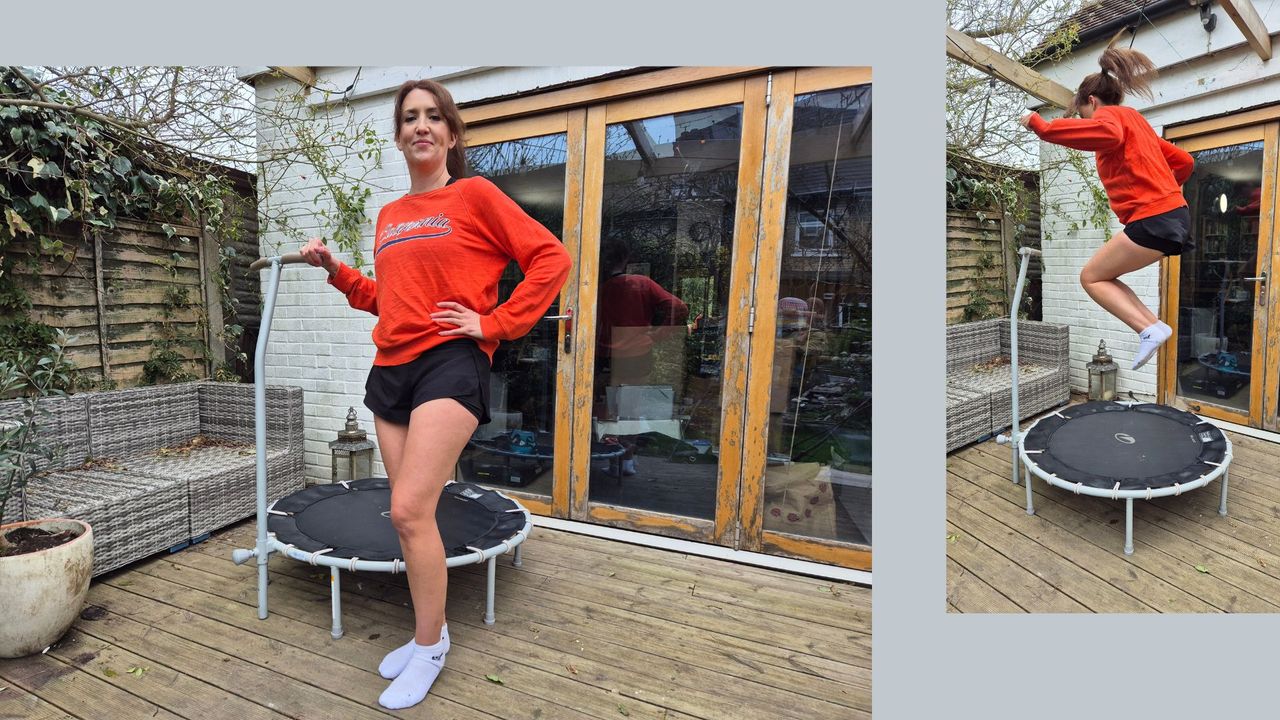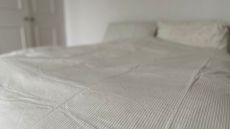I swapped cardio for a trampoline workout - here's why it's changing my routine for good this summer
A trampoline workout can get your heart rate up, boost strength, and improve your balance. Here's what happened when I did it instead of my regular cardio...

Workouts on a fitness trampoline (aka, a rebounder) can improve your cardio fitness, support bone health, and improve your balance - trust me, I swapped my regular workouts for using one for two weeks.
As we speak, there's a mini trampoline sitting at the end of my garden. It's not for kids - it's for me. After years of watching my children have all the fun, my interest in trampolining for fitness was piqued after reels featuring the likes of Nadia Sawalha, Eva Longoria, and Kate Beckinsale jumping about on their rebounders started popping up on my social media.
Normally, my weekly routine consists of strength training, swimming, and yoga. Aside from the occasional jog, I don't do any cardio. I know I need to change this, but I'm rarely motivated to actually do any. I find running boring and HIIT quite off-putting. Could a regular trampoline workout, also known as 'rebounding', be the answer? And with rebounding also classed as a form of resistance training, could I even swap my gym dumbbell workout for these more convenient workouts at home?
What is a trampoline workout?
A trampoline workout, or rebounding, is a low-impact form of aerobic exercise - but there’s more to it than simply bouncing up and down. “It’s a great cardio workout for both complete beginners and the more experienced because there are so many modifications, such as incorporating light weights or resistance bands,” explains Georgina Gikunoo, a certified personal trainer and fitness hub manager for GLL (London East). A typical trampoline workout can include moves such as twists, jumping jacks, arm swings and footwork – like a dance routine on a very springy floor.
And the benefits are numerous. “It improves posture, burns calories and leaves you feeling energised. Over time, it will increase lean muscle and improve bone health, plus reduce stress and anxiety," she says. "It’s a fun bouncy workout that trains your pelvic floor, tones your body, and increases your energy levels. Afterwards, you'll feel great for doing it.”
What's not to love? I was keen to see whether a regular trampoline workout could replace my go-to cardio in the gym (usually a treadmill workout or rowing machine), so I set out to try it. But where should a beginner start? Many PTs recommend starting with 5 to 10-minute sessions, building up to 30 to 45 minutes, at least every other day.

Rebounders come in all sizes so you can find an option for indoor or outdoor workouts.
Gikunoo suggests going at an intensity that is just over half my maximum heart rate (220 minus age) but at a pace that allows me to progress, adding: “Beware of muscle fatigue, which may cause soreness and pressure on your lower back due to gravity constantly pulling you down while you push off the rebounder. There’s a possibility of losing your balance on the rebounder, so always keep knees slightly bent.” You could use a trampoline with a handlebar if needed.
Sign up for the woman&home newsletter
Sign up to our free daily email for the latest royal and entertainment news, interesting opinion, expert advice on styling and beauty trends, and no-nonsense guides to the health and wellness questions you want answered.
Benefits of doing a trampoline workout
For the challenge, I used a DOMYOS Fit Trampo 500 at home and followed YouTube workouts from the likes of Jump & Jacked and Michelle Briehler – both of whom offer videos demonstrating the best form for rebounding, including specific moves. After a lot of jumping about, here’s how trampolining every other day for a fortnight changed my fitness routine…
1. Boosts cardiovascular fitness
I eased myself in with short beginner workouts of around 10 minutes at a time, but still found myself out of breath - be warned, rebounding can feel relentless at first. After a few days, my stamina improved as I extended the length of my workouts. Needless to say, every workout prompted a spike in heart rate into the ‘vigorous’ zone, according to my Fitbit.
Interestingly, a study by NASA (astronauts use rebounding to regain muscle mass and bone density when they return from space) found that rebounding was 68% more effective at increasing oxygen intake than running. I took this as a great excuse to swap jogging on the gym treadmill for a trampoline at home.
“Push a little more each week and your lung capacity and endurance will improve considerably,” says Gikunoo, who adds that by the four-week mark I would start to see noticeable results. “This will enable you to add sessions including weights, which will speed up your recovery time, burn extra calories, build lean muscle and give you the confidence to do more.”
2. Strengthen your pelvic floor
Anyone who’s had a baby or is over 40 will know the feeling - if you want to know exactly how strong your pelvic floor is, a quick bounce on a trampoline will tell you! But regular bouncing may help turn this around - no pelvic floor trainer required.
Rachael Sacerdoti, a PT and nutritionist, says: “Many women experience weakening of the pelvic floor muscles, and rebounding can help strengthen this area. The controlled bouncing engages this muscle group naturally without the strain of high-impact exercises, so it’s a gentle way to increase the strength of your pelvic floor.”
To target the right muscles, it’s recommended you start slow and jump low, engaging your core while bouncing. It was hard to ignore my pelvic floor during a trampoline workout, and engaging the right muscles became second nature the more I did it. It also proved a useful reminder to back it up with a few (often forgotten) Kegel exercises when off the rebounder.
3. Supports bone and muscle health
Unlike running or HIIT, rebounding is a cardio workout that’s low-impact due to the bounce mat absorbing the shock of each jump. As bone density and muscle mass decline in perimenopause, this makes it a particularly good cardio exercise for women over 40, according to Sacerdoti: “Workouts such as rebounding provide up to 80% less impact on joints compared to running on hard surfaces.”
Unsurprisingly, I found that my lower body muscles, particularly my calves, bore the brunt of those initial trampoline workouts. Although several online workouts incorporate arm movements, I felt it wasn’t delivering the kind of ‘total body workout’ that a strength training session at the gym can do. So, as recommended by Gikunoo, I occasionally held some light dumbbells and improvised with my arms. With this, I felt like my upper body had also been worked, albeit not as much as my legs.
4. Improves balance and coordination
At the beginning, I felt like a clumsy elephant during my workouts. Coordinating arms and legs while continually bouncing up and down takes some getting used to, but practice makes perfect. My rebounder has a T-bar handle which I grabbed whenever things felt a bit too wobbly.
Good balance is known to be a marker of health and longevity. Not only does it help reduce the risk of injury from falls, particularly as we age, but research has found poor balance to be associated with cognitive problems and shorter life expectancy. Looking for the best exercise for longevity? This could be it.
Practising balance exercises from any age, including coordinated trampoline workouts, can improve overall mobility and lessen the risk of health problems in the future. A study in the Journal of Electromyography and Kinesiology even discovered that 14 weeks of mini trampoline workouts increased seniors’ ability to regain their balance before falling by around 35%.
5. A trampoline workout can boost your mood
Like most exercises, trampolining will give you a rush of feel-good hormones, such as endorphins and serotonin. But there’s something playful and childlike about bouncing that adds an element of joy, let alone the stress-reducing, meditative nature of the bouncing rhythm. Rebounding has even been recommended as a therapeutic activity for people suffering from poor mental health.
Once I’d spent a few days following online workouts and had mastered a few standard moves, I freestyled several workouts, jumping along to my favourite playlists. Bouncing about in the garden before breakfast proved to be a great way to start the day.
Also, the motivation to squeeze in a quick workout was much higher when I committed to a freestyle session. Who else wouldn’t enjoy bouncing about to their favourite tunes in the morning sunshine and afterwards knowing that your daily fix of cardio was already in the bag?

Several fitness trampolines come with handlebars, either a T-bar or arch-shape, such as the HOMCOM Foldable Fitness Trampoline and the DOMYOS Fit Trampo 500. I've been using the latter for the last few weeks and I appreciate the handlebar for stability.

You can pay hundreds for a high-spec trampoline (such as the Bellicon) but decent budget options under £50 include the Opti Mini Fitness Trampoline. It doesn't have a supportive handlebar but for £40 and almost 100 5-star reviews, you can't go far wrong.

If you're looking to do a full-body workout on your trampoline, you'll likely need some light dumbbells to incorporate some arm movements into the mix, per Sacerdoti's advice. This set from Songmics has three options, stored in a handy tree, ranging from 1 to 3kg.
The verdict
After two weeks, the fitness trampoline still gets regular use. Since rebounding, I haven’t (reluctantly) dragged myself onto a treadmill for a run or touched the gym’s rowing machine. It’s been a great way to elevate my heart rate and get the blood pumping before work, all without the occasional twinges in my knees and ankles that running on a hard surface can bring. Above all, I really enjoy it and find I’m doing far more cardio per week than I did before.
But is it a decent replacement for everything I could do at the gym, which is not only cardio but also strength and resistance training? Sacerdoti suggests that it depends on my overall goals: “Rebounding is exceptional for cardiovascular fitness and lymphatic health, but it’s not a complete replacement for resistance training. If building muscle strength is your goal, you’ll need to incorporate weight training as part of your routine. While rebounding does engage muscles, particularly the core, it doesn’t provide the progressive resistance needed for substantial strength gains.
“It’s a good option if you dislike running though, as rebounding will give you comparable cardiovascular benefits with significantly less joint strain. For example, a 20-minute rebounding session can burn similar calories to a 30-minute run.”
Best trampoline workout for beginners
If you’re new to rebounding, Sacerdoti recommends starting with a short 5 to 10-minute session three times a week. This can be gradually increased to longer sessions as your fitness improves.
“Start with smaller bounces – it’s about control, not height. Form is everything. Keep a slight bend in your knees, engage your core, and focus on pushing through the whole foot rather than bouncing on your tiptoes. Focus on maintaining balance before attempting the more complex movements.”
Try Sacerdoti’s beginner’s routine by repeating this circuit two to three times in one session. As you progress, add some light dumbbells (1-2kg) to work the arms while bouncing.
The routine
- 2-mins of gentle bouncing to warm up
- 1 min of light jogging in place
- 1 min of side-to-side bounces (feet together, bouncing left to right)
- 1 min of knee lifts, alternating on both sides
- 1 min of jumping jacks
- 1 min gentle cool-down bounce
Are trampoline workouts good for weight loss?
Sacerdoti agrees that regular trampoline workouts can support weight loss goals. “A 30-minute moderate-intensity session can burn up to 300 calories, depending on your weight. The combination of cardiovascular exercise with the increased G-force from bouncing creates a unique metabolic environment that can increase your metabolic rate for hours after the workout ends," she says.
“However, as with any exercise, consistency is key. Rebounding three to four times weekly, combined with proper nutrition, will help you achieve results faster,” she says.
Rebounder vs trampoline: What's the difference?
These terms are often used interchangeably but there are subtle differences between the two. ‘Trampoline’ can describe both the larger, recreational bouncer, as well trampolines used for sport or fitness. ‘Rebounder’ is the common term for a fitness trampoline and describes a mini bouncer that supports just one person at a time. Search online for “mini trampoline”, “fitness trampoline” or “rebounder” for the exercise variety instead of something for the playground.
When choosing the best fitness trampoline or rebounder for you, check the product specifications such as the maximum weight it can take (most rebounders are built to support well over 100kg), and whether it is made for indoor or outdoor use. Storage is an important consideration, particularly if you want to use it inside, so check overall size, whether the legs are easily removed, or it folds down.

Kerry is a freelance writer covering health, fitness and wellbeing. With bylines in several national publications alongside woman&home - including Stylist, Red, Metro, Good Housekeeping and more. She has written about the latest news and trends in exercise, nutrition, mental wellbeing, alternative health, ecotherapy, health tech, relationships...in fact, anything that impacts our bodies and minds. Outside of work, she can be found doing her most important job (parenting) while trying to squeeze in time for exercise and escaping into nature whenever possible.
-
 Did you know that TOAST makes bedding? It's a glorious treat
Did you know that TOAST makes bedding? It's a glorious treatTOAST's Rowan Print Bedding is a double-sided set of sleep luxury. Crafted from weighty, organic cotton, it's the epitome of dreamy, premium bedding
By Laura Honey Published
-
 Remember Sienna Miller's Ralph Lauren suit? We're recreating it with this dreamy denim two-piece
Remember Sienna Miller's Ralph Lauren suit? We're recreating it with this dreamy denim two-pieceWe fell in love with Sienna Miller’s pinstripe Ralph Lauren suit when she wore it to Wimbledon back in 2023, and we've finally found the ideal high street alternative.
By Charlie Elizabeth Culverhouse Published

